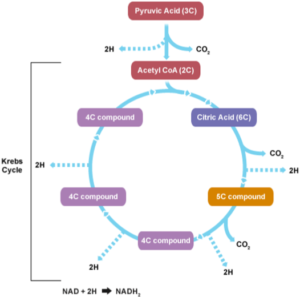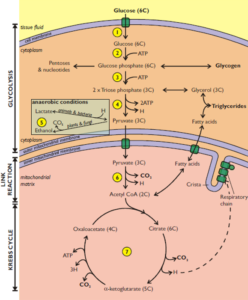The Krebs cycle involves a series of oxidation-reduction reactions that take place in the matrix of the mitochondria.
1. A 2 carbon acetylcoenzyme A from the link reaction combines with a 4 carbon molecule to produce a 6 carbon molecule
2. This 6 carbon molecule loses carbon dioxide and hydrogen to give a 4 carbon molecule and a single molecule of ATP produced as a result of substrate-level phosphorylation
3. The 4 carbon molecule can now combine with a new molecule of acetylcoenzyme A to begin the cycle again
Coenzymes
Coenzymes are molecules that some enzymes require in order to function. Coenzymes play a major role in photosynthesis and respiration where they carry hydrogen atoms from one molecule to another.
NAD important in respiration FAD important in the Krebs cycle NADP important in photosynthesis
The Significance of the Krebs Cycle
- It breaks down macromolecules into smaller ones; pyruvate is broken down into carbon dioxide
- It produces hydrogen atoms that are carried by NAD to the electron transport chain for oxidative phosphorylation This leads to the production of ATP that provides metabolic energy for the cell
- It regenerates the 4 carbon molecule that combines with acetyl coenzyme A which would otherwise accumulate
- It is a source of intermediate compounds used by cells in the manufacture of other important substances such as fatty acids, amino acids and chlorophyll


